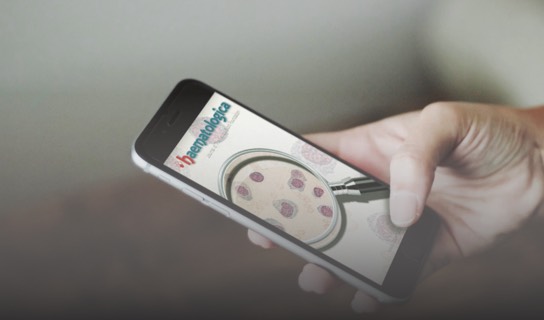CURRENT ISSUE
EDITOR'S PICKS
Review Article
Emicizumab: the hemophilia A game-changer
ARTICLES IN THREE SENTENCES

Article
Pharmacologic targeting of the p62 ZZ domain enhances both anti-tumor and bone-anabolic effects of bortezomib in multiple myeloma
Ways to increase the anti-multiple myeloma (MM) efficacy of proteasome inhibitors (PI) are needed to improve therapeutic responses, disease-free survival, and bone health in MM patients. Through in vitro and in vivo experiments, Marino and colleagues studied the activity of a small molecule ligand of the ZZ-domain, XRK3F2, that decreased osteoclast formation and activity, and reversed MM-epigenetic suppression of osteoblast differentiation. They showed that XRK3F2 boosts both the anti-tumor and bone-anabolic effects of PI and provide a strong rationale for developing a new therapeutic regimen based on co-administration of XRK3F2 and bortezomib to treat MM.

Letter
Acute myeloid leukemia-driven IL-3-dependent upregulation of BCL2 in non-malignant hematopoietic stem and progenitor cells increases venetoclax-induced cytopenias
Venetoclax-containing regimens, which are standard of care for unfit patients with acute myeloid leukemia (AML), are associated with high incidences of clinically relevant cytopenias. The underlying cause of these cytopenias is unexplained, and the lack of venetoclax effect on BCL2 expression in mature hematopoietic lineages suggests that the observed cytopenias are driven by changes in non-malignant hematopoietic stem and progenitor cells (HSPC). With their research, Fowler-Shorten and colleagues show that AML induces an IL-3-dependent upregulation of BCL2 in HSPC, which in turn increases HSPC sensitivity to venetoclax and causes cytopenias.

Article
Impaired hemoglobin clearance by sinusoidal endothelium promotes vaso-occlusion and liver injury in sickle cell disease
Recent evidence in sickle cell disease (SCD) suggests that liver sinusoidal endothelial cells (LSEC) support the tethering of damaged erythrocytes to hepatic sinusoids. Kaminski and colleagues performed an in-depth study of primary human LSEC in SCD through real-time intravital (in vivo) imaging in mice liver together with flow cytometric analysis and confocal imaging. They showed for the first time that liver injury in SCD is associated with accumulation of hemoglobin-S and iron in the LSEC, leading to senescence of these cells.

Letter
Rituximab plus cyclophosphamide and dexamethasone versus bortezomib plus cyclophosphamide and dexamethasone in newly diagnosed symptomatic Waldenström macroglobulinemia: a randomized controlled trial
Rituximab-based and bortezomib-based regimens have shown efficacy in the treatment of Waldenström macroglobulinemia (WM), a rare B-cell lymphoma. Xiong and colleagues present results of the randomized, controlled phase III trial comparing the activity of rituximab, cyclophosphamide, and dexamethasone (RCD) with that of bortezomib, cyclophosphamide, and dexamethasone (BCD) in newly diagnosed patients with WM. For the first time, they demonstrated that RCD is superior to BCD in terms of both progression-free and overall survival.
TAKE ADVANTAGE FROM HAEMATOLOGICA





